Top Questions
Top Questions About Collecting Coins
We've compiled some of our most frequently asked questions and organized them by category. Choose your topic and read the answers below.
- What makes a coin valuable?
- Is the metal in the coins valuable?
- When were coins first used?
- When were the first U.S. coins used?
- How many different denominations have there been?
- How old is coin collecting?
- Why is coin collecting so popular?
- Should I be worried about discoloration?
- How do I get started?
1. What makes a coin valuable?
A coin is not necessarily valuable merely because of age. For example, some Roman coins more than 1,600 years old can still be purchased today for $20 or even less! The value of a coin, like most items, is determined by supply and demand.
Demand is obviously a major factor. Some coin types, such as Buffalo nickels or Mercury dimes, are more popular than others of the same denomination. Thus, more collectors are seeking the same coins, so their prices will be affected. A coin’s value is determined by the interrelated factors of scarcity, condition and demand.
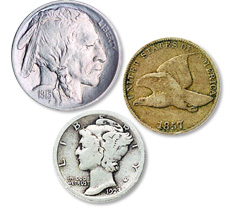
Buffalo Nickel, Flying Eagle Cent and Mercury Dime
Perhaps more coins of an earlier date may have been produced than those of a later date, so coins that are far older may still be available. This is supply. Of course, it all depends on how many of each has been saved, and in what condition. A coin’s condition (the state it has been preserved in) is an extremely important factor in its value. An Uncirculated piece may be worth ten times or thousands of times as much as an average circulated coin of the same date. To learn more about coin grading, see our grading guide.
2. Is the metal in the coins valuable?

America’s most popular silver and gold coins, the Morgan Silver Dollar of 1878-1921 and the Saint‑Gaudens $20 Gold Double Eagle of 1907‑1933
Gold and silver coins have a dual value – their numismatic or collector value, and their intrinsic or precious metal value. Coins of higher grades will have a greater premium over their metal value than coins of lesser grade or condition. Some quantities of 90% gold U.S. coins (last minted for circulation in 1933), and 90% silver U.S. coins (last minted for circulation in 1964), are still available to collectors today. A $20 gold piece, or double eagle, weighs nearly one full ounce. A Morgan silver dollar contains over ¾ ounce of pure silver. However, the numismatic worth of U.S. coins usually outweighs any bullion value. Learn more about silver and gold value.
3. When were coins first used?
Though the first coins are actually attributed to Lydia in Asia Minor around 600-700 B.C., it is now believed that bronze coins were used in China several hundred years earlier.
However, the Lydians were probably not aware of China’s existence, so their coins – called “Staters” (a unit of weight) – were invented separately. These first Staters were made of electrum, a natural alloy of gold and silver.

Lydia Silver Drachm, 480-460 B.C.; Electrum 1/8 Stater from Phokaia, 480‑400 B.C.
4. When were the first U.S. coins used?
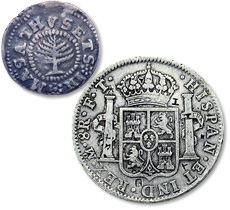
Pine Tree Silver Shilling of 1652; Spanish Silver 8 Reales
Early American “money” consisted primarily of wampum, beaver skins, and tobacco, items used by Native Americans and early settlers. The colonists had no use for coinage until foreign traders arrived and demanded payment for goods. Most “hard currency” tended to flow back across the Atlantic, so Massachusetts Bay Colony took matters into their own hands and struck some of our earliest silver coins in 1652: the NE (New England) silver Threepence, Sixpence and Shilling, followed by the Willow Tree and Pine Tree coinage. Other foreign coins like Spanish silver Pieces of Eight (8 Reales) also circulated. After America won independence and the first U.S. Mint opened in 1793, we began to strike our own national coinage.
5. How many different denominations have there been?
Today, the U.S. Mint produces coins for circulation in these denominations: cent, nickel, dime, quarter, half dollar, and dollar. Plus, commemoratives in both gold and silver are issued in various denominations. In the past, the mints have produced many different denominations of coins, such as half cents, 2¢ pieces, 3¢ pieces, half dimes, and 20¢ pieces.
Gold coins have been produced for circulation in these denominations: $1, $2.50, $3, $5, $10 and $20 pieces, as well as a few hundred patterns for a $4 gold piece that was never mass-produced.
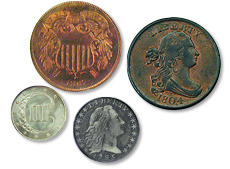
From top right: the U.S. Half Cent, Two-Cent Piece, Silver Three-Cent Piece and Half Dime
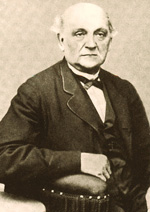
Joseph Mickley of Philadelphia was the first famous American collector. His hunt for a Large Cent from the year of his birth began the tradition
of collecting all of the coins of a series from
every year of issue.
[Photo courtesy of Q. David Bowers]
6. How old is coin collecting?
The earliest known coin collector was the Roman emperor Augustus. Coin collecting became even more popular during the Middle Ages, when wealthy persons and royalty assembled magnificent collections. The hobby was confined mostly to the rich, since the general population needed every coin to pay for food, clothing and shelter.
In the U.S., collecting also began with the wealthy, but by 1858, there were enough active collectors to form the American Numismatic Association. Since the 1920s, with U.S. commemoratives, and the 1930s, with penny boards and folders, this hobby has grown steadily. Today, with many exciting coins to collect, there are more than 100 million collectors in the U.S. alone.
7. Why is coin collecting so popular?
Coin collecting is an exciting hobby because coins and currency still in circulation today were sometimes used during historic periods of America's past. Coins can recall exciting periods in American and world history, and for the most part have been issued by official governments. No matter how much time you spend on a collection, you get a sense of satisfaction and pride. At the end of a long day, you can relax as you go through it coin by coin. Your coins will probably outlive you by hundreds or thousands of years! Take care of them, and future collectors will appreciate your thoughtfulness.

People of all ages and from all walks of life enjoy the hobby of collecting coins. When you hold a coin in your hand, you’re holding a tangible link to the past.
8. Should I be worried about discoloration?
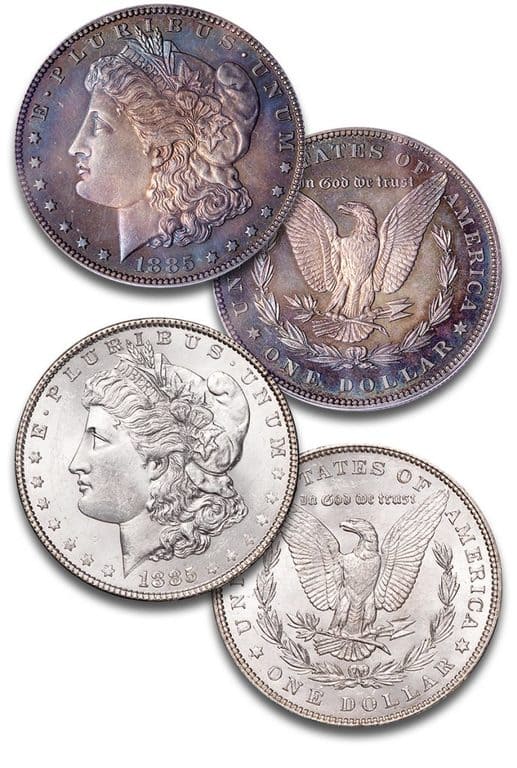
Over time, a coin’s natural silver color can shift to a range of beautiful colors – like the blue and purple hues shown above.
Not necessarily. All coins experience what’s known as natural toning. Why? They contain metals that chemically react with air, heat and moisture. They also react to sulphur found in such storage materials as mint bags, paper rolls and coin envelopes. Results can fluctuate from solid colors to multi-colored, iridescent hues. Toning can cover just the periphery, part of the surface, or the entire surface. It can range from light to dark, or even exhibit a mottled look. Our experts have been trained to recognize color caused by damage so we can make sure you only receive the best quality when buying from LCC.
The two best known examples of toning are Lincoln cents and silver coins. A cent’s original color is copper when it leaves the mint, then shifts to red-brown, and then to brown. Silver coins experience a wide range of toning colors: muted grey, yellow and brown to shimmering blues and purple. In coin collecting, many people prefer toning because it’s one indicator that the coin is still in original Uncirculated condition!
9. How do I get started?
There are several popular ways to collect. At first, you may have a general collection containing a variety of different coins. As you acquire examples of coins – perhaps a Morgan dollar, Liberty Walking half dollar, Buffalo nickel or Barber dime – you will find yourself attracted to certain ones. But the most important thing to remember is to develop a plan.
You may want to assemble a complete set – every date and mint mark of the Lincoln cent, for example. Or you may prefer to collect one example of each different dime, and then tackle quarters in this same fashion.
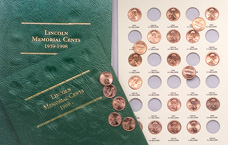
An example of a date and mint mark collection
Another favorite way to collect is by type. Type collecting is assembling coins of different designs. It may be coins of the 20th century, coins of any one denomination, or perhaps a specimen of each coin type minted in silver or copper. Collecting by type can give you a full overview of coin designs and how they have progressed through time.
Often, when a complete set might exceed one’s budget, you can assemble a year set – one coin from each year within a series. You’ll have an authentic, official souvenir from every year of a particular period in U.S. history. For example: a year set of Franklin halves would include one coin from each year 1948-1963. (A complete set would require a 1948, ’48‑D, ’48‑S, ’49, ’49‑D, ’49‑S, etc.) Learn more about mint marks (“D”, “S”, etc.) or about other ways to collect coins.
Where to go from here
New to collecting? This handy beginner's guide is full of tools and links get you started on your first collection.
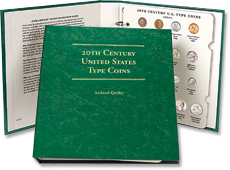
A U.S. Type Set containing
19th & 20th‑century coins

